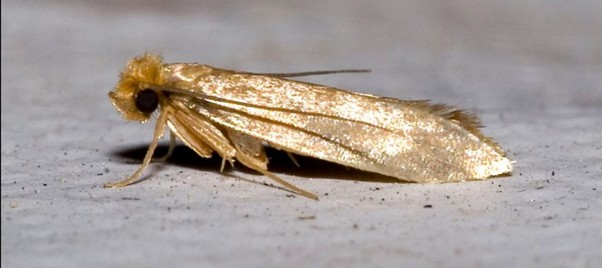Carpet moths are a perplexing pest in UK homes, appearing seemingly out of nowhere to wreak havoc on carpets, clothes, and upholstery. For homeowners puzzled by their presence, a common question emerges: Where do carpet moths come from? The answer lies in a mix of environmental factors, human habits, and their sneaky lifecycle. ThermoPest, a UK pest control expert, offers heat treatment to eliminate them at the source—learn more at our heat treatment page.
In this guide, we’ll unravel the mystery of where do carpet moths come from? for UK households, tracing their origins and showing how ThermoPest can end their invasion. Curious about moth basics? Check our moth information page. Let’s solve this household puzzle.

What Are Carpet Moths?
Carpet moths—chiefly the common clothes moth (Tineola bisselliella) and case-bearing clothes moth (Tinea pellionella)—are small insects whose larvae feed on natural fibres like wool, silk, and feathers. Adults don’t eat, but their larvae cause the damage, targeting keratin-rich materials. In the UK, our damp climate and fibre-heavy homes make them a recurring issue. Where do carpet moths come from? It’s a blend of nature and nurture—get the science at Wikipedia’s clothes moth page.
Where Do Carpet Moths Come From? The Origins
So, where do carpet moths come from? They don’t just appear—they arrive or emerge through specific pathways:
- Outdoor Entry: Adult moths drift in from gardens or neighboring homes via open windows, doors, or cracks, drawn to dark, fibre-rich indoors.
- Second-Hand Goods: Used furniture, rugs, or clothes from charity shops or attics can carry eggs or larvae, introducing them unnoticed.
- Existing Infestations: A small, undetected population in carpets or wardrobes spawns new generations, spreading within your home.
In the UK, these origins thrive—our weather and habits fuel the mystery. ThermoPest’s heat treatment stops them—contact us to cut them off.
Why UK Homes Are Moth Magnets
Where do carpet moths come from? ties to why they love UK households:
- Damp Climate: Humidity softens fibres and speeds larval growth, as noted in a BBC News pest report.
- Natural Fibres: Wool carpets, silk curtains, and cashmere jumpers are irresistible to larvae.
- Older Homes: Cracks, attics, and undisturbed corners offer entry and breeding spots.
These factors turn UK homes into moth havens, explaining their mysterious arrivals. ThermoPest’s heat treatment clears them out—see our treatment page.
How They Spread Once Inside
Understanding where do carpet moths come from? includes how they multiply. Adults lay 40-100 eggs in 2-4 weeks, hatching in 4-10 days. Larvae feed for 1-6 months, spinning webs and moving to new fibres—carpets to clothes, upholstery to bedding. In UK homes, this spread is rapid, turning a single entry into a full infestation. Spot them early with tips from our moth page.
Signs Carpet Moths Have Arrived
To solve where do carpet moths come from?, watch for these clues:
- Bald patches on carpets or holes in fabrics.
- Silky webs or cocoons in corners or seams.
- Cream larvae (5-10mm) in dark nooks or wardrobes.
- Small golden or grey moths (6-8mm wingspan) fluttering about.
- Frass—tiny droppings near damage.
These signs pinpoint their source—whether from outside or within. ThermoPest can trace and end them—contact us.
Why DIY Won’t Stop the Source
UK residents might vacuum, seal gaps, or use cedar to tackle where do carpet moths come from?, but these don’t fully work. Vacuuming misses eggs, sealing stops new entries but not existing ones, and repellents only deter adults. The origin—be it a rug or wardrobe—stays active. ThermoPest’s heat treatment, at over 55°C, kills all stages wherever they’re from—chemical-free and thorough.
ThermoPest’s Heat Treatment: Ending the Mystery
When where do carpet moths come from? hits your home, ThermoPest’s heat treatment solves it. We heat infested areas to over 55°C, wiping out eggs, larvae, and adults in one go—inside or out. It’s eco-friendly, leaves no residue, and fits UK homes with damp corners and wool. One session ends the invasion—learn how at our treatment page. Ready to stop them? Contact us.
Preventing Future Arrivals
Keep the mystery solved:
- Vacuum often, though it won’t kill eggs.
- Inspect second-hand buys for eggs or larvae.
- Seal cracks and use dehumidifiers to dry damp spots.
- Monitor with sticky traps to catch early fliers.
ThermoPest offers custom prevention—see our moth page.
The Cost of Unsolved Origins
Not addressing where do carpet moths come from? risks damage piling up. Months of larval feeding ruin carpets, clothes, and more—costly in UK homes with natural fibres. The BBC News piece flags rising pest issues, urging action. ThermoPest’s heat treatment prevents this—contact us to save your home.
Final Thoughts on Where Do Carpet Moths Come From?
So, where do carpet moths come from? Outdoor drift, second-hand items, or hidden home pockets—UK homes invite them through climate and habit. ThermoPest’s heat treatment ends the mystery, killing them at every stage. Explore it at our treatment page, learn more at our moth page, or contact us. No more wondering—solve the moth mystery today.
